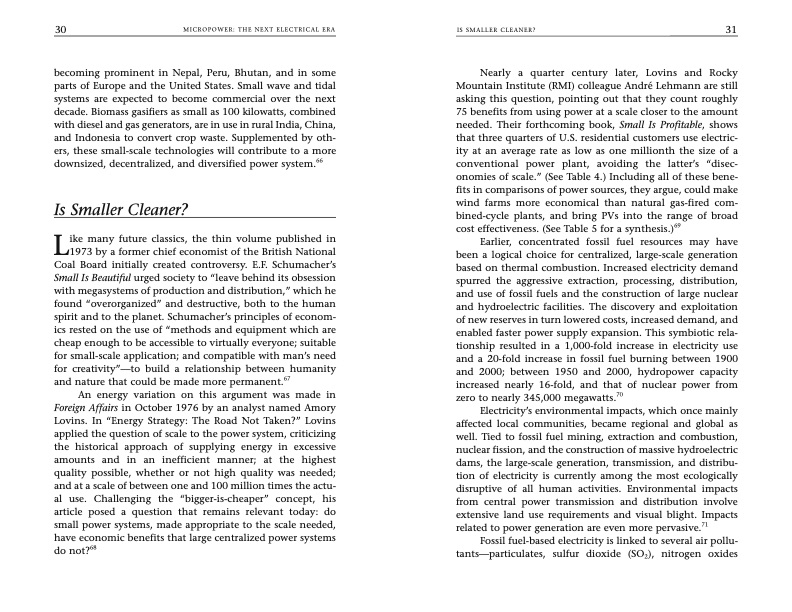
PDF Publication Title:
Text from PDF Page: 016
30 MICROPOWER: THE NEXT ELECTRICAL ERA IS SMALLER CLEANER? 31 becoming prominent in Nepal, Peru, Bhutan, and in some parts of Europe and the United States. Small wave and tidal systems are expected to become commercial over the next decade. Biomass gasifiers as small as 100 kilowatts, combined with diesel and gas generators, are in use in rural India, China, and Indonesia to convert crop waste. Supplemented by oth- ers, these small-scale technologies will contribute to a more downsized, decentralized, and diversified power system.66 Is Smaller Cleaner? Like many future classics, the thin volume published in 1973 by a former chief economist of the British National Coal Board initially created controversy. E.F. Schumacher’s Small Is Beautiful urged society to “leave behind its obsession with megasystems of production and distribution,” which he found “overorganized” and destructive, both to the human spirit and to the planet. Schumacher’s principles of econom- ics rested on the use of “methods and equipment which are cheap enough to be accessible to virtually everyone; suitable for small-scale application; and compatible with man’s need for creativity”—to build a relationship between humanity and nature that could be made more permanent.67 An energy variation on this argument was made in Foreign Affairs in October 1976 by an analyst named Amory Lovins. In “Energy Strategy: The Road Not Taken?” Lovins applied the question of scale to the power system, criticizing the historical approach of supplying energy in excessive amounts and in an inefficient manner; at the highest quality possible, whether or not high quality was needed; and at a scale of between one and 100 million times the actu- al use. Challenging the “bigger-is-cheaper” concept, his article posed a question that remains relevant today: do small power systems, made appropriate to the scale needed, have economic benefits that large centralized power systems do not?68 Nearly a quarter century later, Lovins and Rocky Mountain Institute (RMI) colleague André Lehmann are still asking this question, pointing out that they count roughly 75 benefits from using power at a scale closer to the amount needed. Their forthcoming book, Small Is Profitable, shows that three quarters of U.S. residential customers use electric- ity at an average rate as low as one millionth the size of a conventional power plant, avoiding the latter’s “disec- onomies of scale.” (See Table 4.) Including all of these bene- fits in comparisons of power sources, they argue, could make wind farms more economical than natural gas-fired com- bined-cycle plants, and bring PVs into the range of broad cost effectiveness. (See Table 5 for a synthesis.)69 Earlier, concentrated fossil fuel resources may have been a logical choice for centralized, large-scale generation based on thermal combustion. Increased electricity demand spurred the aggressive extraction, processing, distribution, and use of fossil fuels and the construction of large nuclear and hydroelectric facilities. The discovery and exploitation of new reserves in turn lowered costs, increased demand, and enabled faster power supply expansion. This symbiotic rela- tionship resulted in a 1,000-fold increase in electricity use and a 20-fold increase in fossil fuel burning between 1900 and 2000; between 1950 and 2000, hydropower capacity increased nearly 16-fold, and that of nuclear power from zero to nearly 345,000 megawatts.70 Electricity’s environmental impacts, which once mainly affected local communities, became regional and global as well. Tied to fossil fuel mining, extraction and combustion, nuclear fission, and the construction of massive hydroelectric dams, the large-scale generation, transmission, and distribu- tion of electricity is currently among the most ecologically disruptive of all human activities. Environmental impacts from central power transmission and distribution involve extensive land use requirements and visual blight. Impacts related to power generation are even more pervasive.71 Fossil fuel-based electricity is linked to several air pollu- tants—particulates, sulfur dioxide (SO2), nitrogen oxidesPDF Image | Micropower: The Next Electrical Era

PDF Search Title:
Micropower: The Next Electrical EraOriginal File Name Searched:
EWP151.pdfDIY PDF Search: Google It | Yahoo | Bing
Capstone Turbine and Microturbine: Capstone microturbines used and new surplus for sale listing More Info
Consulting and Strategy Services: Need help with Capstone Turbine, sizing systems, applications, or renewable energy strategy, we are here to assist More Info
Container Lumber Dry Kiln: Since 1991 developing and innovating dry kilns using standard shipping containers More Info
Supercritical CO2 Lumber Dry Kiln: Compact fast drying in 3 days or less for small amounts of wood and lumber drying More Info
BitCoin Mining: Bitcoin Mining and Cryptocurrency... More Info
Publications: Capstone Turbine publications for microturbine and distributed energy More Info
FileMaker Software for Renewable Energy Developing database software for the renewable energy industry More Info
CO2 Gas to Liquids On-Demand Production Cart Developing a supercritical CO2 to alcohol on-demand production system (via Nafion reverse fuel cell) More Info
Stranded Gas for low cost power Bitcoin Mining Using stranded gas for generators may provide breakthrough low power costs for cryptocurrency miners. More Info
| CONTACT TEL: 608-238-6001 Email: greg@globalmicroturbine.com | RSS | AMP |